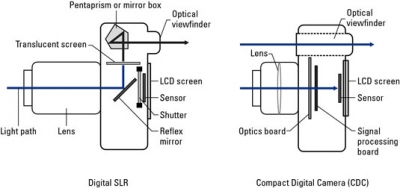
Two of the mist widely used cameras are the compact and the single-lens reflex (SLR). Both use 35mm film, although a few SLRs, including the Hassrlblad, use 120 film – 2¼ in (60 mm) wide – which needs less enlarging so gives better definition.
The two types differ in two main ways. First, most compacts have one built-in lens whereas the SLR can be fitted with a variety of interchangeable lenses. Secondly. The compact has a separate viewfinder whereas the SLR has a reflex viewfinder which ‘sees’ through the camera lens.
With a separate viewfinder, the photographer’s view does not coincide exactly with that of the lens (this is known as parallax error), so some compensation is needed for close-ups. With a reflex viewfinder, the photographer can see exactly the image that will be thrown onto the film, because light entering the camera lens is reflected by a mirror through a pentaprism (a five-sided prism)
to the viewfinder eyepiece. The pentaprism reverses the mirror image and presents it to the eye the right way round. When the shutter release is pressed, the mirror springs upwards to let the light from the image onto the film.
The compact is smaller than the SLR, is easy to operate, and has few controls. The most expensive models have automatic focusing, automatic exposure, a zoom lens, built-in flash, and motor-driven film wind-on. They can take pictures comparable in quality to many SLRs.
SLR cameras can be programmed for auto-exposure in different ways – for example, a suitable aperture is automatically chosen for a manually selected shutter speed, or the other way round. Often the exposure meter has an indicator in the viewfinder to show the combination of aperture and shutter speed being set for optimum exposure.
The latest S;R models have built-in microprocessors controlling auto-focusing, auto-exposure and motor-driven wind-on. They can be fitted with a range of interchangeable backs offering different features, such as using different film and printing various information on the film.
Picture Credit : Google

